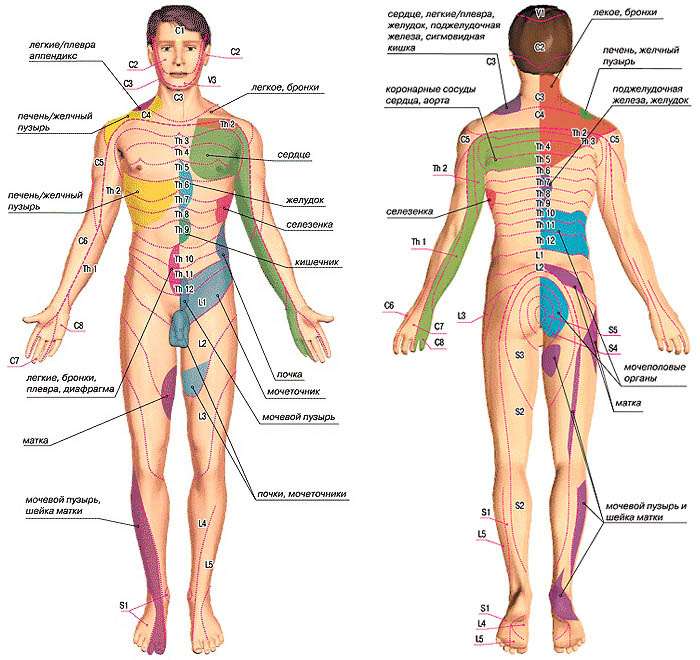Zakharyin-Geda Zones
Applique devices Lyapko in the process of application come into direct contact with human skin. But we are talking about the fact that the healing effect is also on the internal organs.
This is due to the presence of Zakharyin-Ged zones on the skin.
Zakharina-Geda zones are limited areas of the skin, in which, with diseases of internal organs, reflected pains often appear, as well as changes in sensitivity in the form of pain and temperature hyperesthesia (hypersensitivity).
The appearance of zones is explained by the spread of excitation from the pathological focus to the segmental apparatus of the spinal cord, which causes skin projections in the zone that is innervated by this segment. Zones can be of both diagnostic and therapeutic value.
Zones of hyperalgesia (abnormally high sensitivity of the body to painful stimuli) are, first of all, auxiliary, important for diagnosis: by establishing the zones of pain and hyperesthesia and comparing their boundaries with the layout of the Zakharyin-Ged zones, one can make an assumption about which internal organ in this case struck.
It is extremely important and interesting for diagnostics that changes in the projection zones of the skin are often observed long before the appearance of pronounced signs of the disease.
The anatomical and physiological basis for the emergence of such zones is the metameric structure of the segmental apparatus of the spinal cord, which has a constant anatomical connection both with certain areas of the skin (dermatomes) and with internal organs (splanchnotomas).
In the process of embryonic development, the interposition of the internal organ and the segment of the spinal cord that innervates it changes significantly, but their neural connections remain. For example, the ovary in the embryo is laid at the level of the neck, and in the process of fetal maturation it moves into the pelvic cavity, while maintaining autonomic nerve connections with the cervical part of the spinal cord. Therefore, with inflammation of the ovary, the reflected pain (aching, dull) is often localized in the neck and shoulder girdle (Lapinsky syndrome).
When an internal organ is damaged, pathological impulses are transmitted along sensitive nerve fibers to the segment of the spinal cord that innervates it and cause excitation of the segmental apparatus, including the second neurons of skin sensitivity and motor neurons (innervating muscles). Prolonged excitation leads to depletion of neurons, which is manifested by hyperesthesia associated with a decrease in the threshold of pain and temperature sensitivity in the corresponding area of the skin (dermatome).
Pathological impulses along the conductors of sensitivity are conducted into the optic tubercle and cerebral cortex, forming a sensation of pain localized within the corresponding dermatome.
The Zakharyin-Ged zones are also used for therapy purposes. The ability to influence from the integument of the body in the area of the projection zones on the corresponding internal organs is primarily widely used in physiotherapy.
Medical experience has shown that some of the acupuncture points coincide with the zones of skin hyperesthesia of Zakharyin-Ged, which is taken into account and used in acupressure, acupuncture and punctuation (point) reflexotherapy.
When feeling your body, you can find those places (zones) that will be painful and especially sensitive.
Pay attention to the table of Zakharyin-Ged zones. Which organ or group of organs does this painful area belong to?
Next, you should think about additional diagnostics of this organ. For example, with increased sensitivity of the inner surface of the left hand, attention should be paid to the work of the heart and blood vessels, etc.
The layout of the Zakharyin - Ged zones on the trunk and limbs

To identify the Zakharyin-Ged zones, several methods are used: light pricks are made with a pin in the area of the skin projection of the affected internal organ (to determine hyperesthesia); lightly squeeze between the thumb and forefinger and slightly lift the skin with subcutaneous tissue (with the pathology of the corresponding internal organ, more or less intense pain occurs); touch a test tube with warm water or a warm wet sponge to the skin in the area of the Zakharyin-Ged zones (in the presence of pathology of the corresponding internal organ, burning and pain are noted).
Identification of pain and hyperesthesia, comparison of its boundaries with the schemes of Zakharyin-Ged zones, suggest the defeat of any internal organ.
However, it should be remembered that hyperesthesia of the same skin areas can occur in diseases of various organs.
Zakharyin-Ged zones are used in reflex therapy of diseases of internal organs, as a place of application of the impact. Apply acupuncture, moxibustion, acupressure, etc.
Thus, we came to the conclusion that by acting on the pain zones of Zakharyin-Ged, it is possible to treat the internal organs by acting on the skin.
Using the Lyapko application devices in these zones, you can indirectly influence the internal organs, normalizing their activity.
